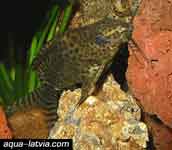|
Featherfin Squeaker

Featherfin Squeaker
Article supplied by Alex Gourgiotopoulos of Kingston, Ontario -
The Featherfin Synodontis originates from the rivers of the White Nile in Africa. It is also know as the Squeaker Synodontis or the Featherfin Squeaker. The Featherfin is a catfish whose name originates from the Greek words "Syno" meaning "close" and "odontis" meaning "tooth", which refers to the teeth of the lower jaw of the fish that are spaced close together. The second attribute of its name, "Eupterus", refers also to the Greek word "Beautiful wings", which refers to its dorsal fin. The Featherfin belongs to the family of Mochokidae and shares its place among approximately 170 species, 50 of which belong to the same group of Synodontis.
Featherfin Squeaker - Color
The Featherfin colour pattern changes quite a lot between its juvenile and adult stage, the juvenile having a body of attractive lines of black and white intervened with irregular spots revealing a "zebra" appearance, only to lose that to a more dull gray/brownish coloration with spots on the body at the stage of adulthood, though keeping a more "lined" appearance at his tail. The feature that makes this catfish unique in its own right is its wonderful dorsal fin, that when raised with all its filaments extended resembles a moving fan and when that is accompanied by its adipose dotted fins, it is certain to make eyes turn.
Featherfin Squeaker - Feeding
As a catfish in the wild, it would have spent its days at the bottom of the rivers and lakes prowling for food with its three pairs of barbells (another characteristic feature of this catfish, since only three other synodontis sport
three pairs of barbells - Synodontis decorus, Synodontis clarias and Synodontis flaevitaeniatus). Being opportunistic and not such a finicky eater, it would have eaten whatever fits in its mouth. In the aquarium it will eat flakes, shrimp pellets and whatever falls at the bottom, but the diet should be enriched with frozen bloodworms and shrimp to keep its diet in a healthy balance.
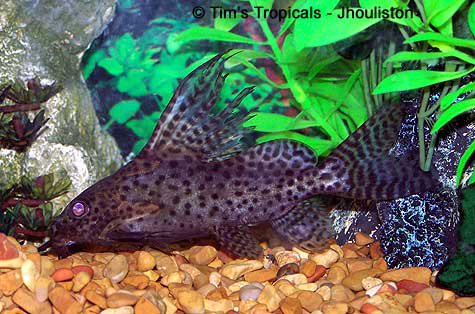
Featherfin Squeaker
Featherfin Squeaker - Aquarium Setup
The Featherfin is quite hardy and can be forgiving and accommodating to a variety of water conditions and tankmates (since it has the protection of his spiked fin), making it an ideal beginner's fish. It is relatively peaceful in temperament, and despite its omnivorous nature, hardly ever bothers other bottom dwellers even if they are very small in size, but can be picky with its tankmates, harassing the unlucky one that it dislikes. Synodontis Eupterus is also quite moody in attitude, therefore it should have caves to dwell in and feel at ease. They usually like a piece of bogwood or a raised area at the bottom of the tank, preferably to overview the tank from a pot of clay and to patrol to show who is the boss. It is not advised to put more than one of its species in a tank, since it can be very territorial with its own and it is a loner. Nevertheless, other species of synodontis can be added, but keep in mind the prospect of aggressive behaviour toward some synos and also some plecos.
Featherfin Squeaker - Breeding
Sex is not easy to differentiate at the juvenile stage, but when they reach adulthood the male is usually more slender, while the female is much more bulky. Breeding has not been successful in hobbyist's aquariums.
Featherfin Squeaker - Handling
Handling should be always with care, because of its spiked dorsal fin, to avoid being stuck, but also to avoid injuring the fish. It is always preferred to use a plastic bag instead of a net to remove the fish to a different location. I have seen a Featherfin lose a whisker against a large rock and then re-grow a new one.
Featherfin Squeaker - Compatibility:
Featherfin Squeakers are compatible with Buenos Aires Tetras, Danios, Dwarf Gouramis, Emperor Tetras, Flame Tetras, Harlequin Rasbora, Head and Tail light Tetras, Kuhli Loaches, Mollies, Platies, Red Eye Tetras, Rosy Barbs, Sailfin Mollies, Serpae Tetras, Silver Dollars, Silver Hatchetfish, Silver Tip Tetras
Featherfin Squeakers are also get along with African and South American cichlids, provided they are not small.
Caution should be used in combining with other synodontis and plecos, as the Featherfin can sometimes be aggressive toward these. There are sad stories out there about the plight of neon tetras with the Featherfin.
Featherfin Squeaker - Profile
-
Scientific Name: Synodontis eupterus
-
Family: Mochokidae, Catfish
-
Temperature: 22 - 26 C; 72 - 79 F
-
pH: 6.5 - 7.5
-
Size: 20 cm; 8 inches
-
Life Span: 15 - 20 years
-
Breeding: Difficult, Egglayer
Featherfin Squeaker - Comments
Comments by lemulepr: - This fish is very
beautiful. But as most big mouth fish, they will eat hatever fits inside it  .
Thats why most people recommend to not mix small Tetras with Cichlids.
The thing with the Neons is that they are small, not so fast, and during the
night they tend to "sleep" in the bottom. Synodontis are kind of nocturnal,
so probably they found a snack there.
Guppies appear bigger because their tails and tend to stay on the top,
where is safer in this case (this is only my opinion). Synodontis require a 50 gallon tank,
as they can grow big. If you want to keep the Synodontis, think about adding bigger tank mates.
Can be other Cichilds or bigger Tetras, like the Congo, Emperor, Buenos Aires, Black Skirts,
etc. Rainbows are medium size and fast moving. Keep an eye on the Guppies, but there is
always something about the Guppies that help them survive with weird tanks mates, .
Thats why most people recommend to not mix small Tetras with Cichlids.
The thing with the Neons is that they are small, not so fast, and during the
night they tend to "sleep" in the bottom. Synodontis are kind of nocturnal,
so probably they found a snack there.
Guppies appear bigger because their tails and tend to stay on the top,
where is safer in this case (this is only my opinion). Synodontis require a 50 gallon tank,
as they can grow big. If you want to keep the Synodontis, think about adding bigger tank mates.
Can be other Cichilds or bigger Tetras, like the Congo, Emperor, Buenos Aires, Black Skirts,
etc. Rainbows are medium size and fast moving. Keep an eye on the Guppies, but there is
always something about the Guppies that help them survive with weird tanks mates,  With bigger tanks, better fish behavoir (my opinion). With bigger tanks, better fish behavoir (my opinion).
Synodontis like hidding, so provide a "cave". Be careful with its
spikes, as they can harm you when they protude through the fish net.
Upside Down Catfish
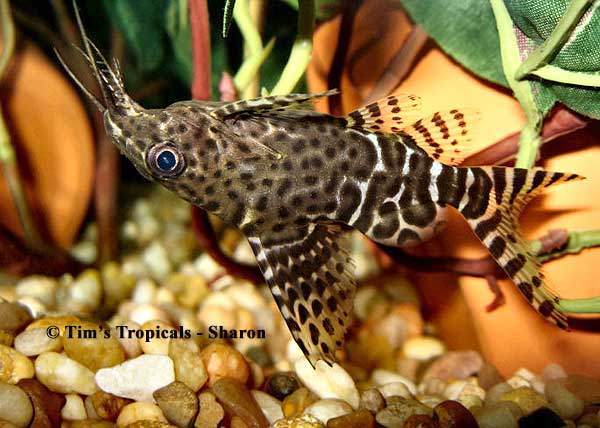
Upside Down Catfish
There are two main species of Synodontis catfish that are
identified as Upside Down Catfish. Both of them originally come from Zaire
in Africa. One is Synodontis Contractus, which is also called the Bugeye
Squeaker. The other is Synodontis Nigriventris, so called because
of its dark belly (remember that would be at the top when it swims). They
are both nocturnal, very active and very peaceful. They have a large
adipose fin.
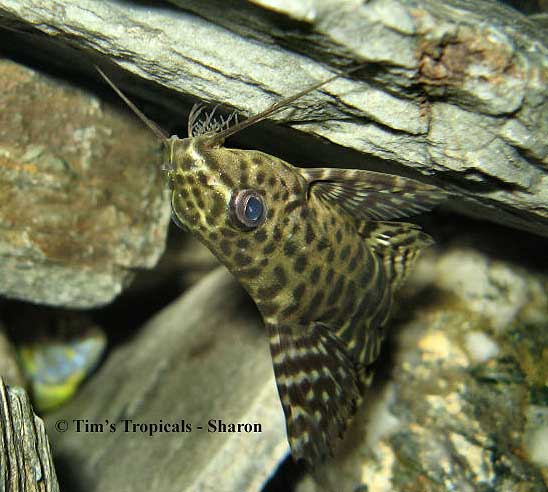
Upside Down Catfish
Upside Down Catfish - Aquarium Setup
Upside Down Catfish spend the daylight hours hiding in caves
and their nights are spent swimming continually upside down. The aquarium
should have flower pots or plastic pipe for them to hide in. A
floating plant cover will help them feel secure. They
are schooling fish and should be kept in groups of at least 4 - 6 whenever
possible. In the wild, they school in much larger groups. Upside
Down Catfish eat flake foods, but should be given live foods too, such as brine
shrimp, blood worms, glass worms, and earthworms.
Females are broader and sometimes lighter. Breeding is very difficult.
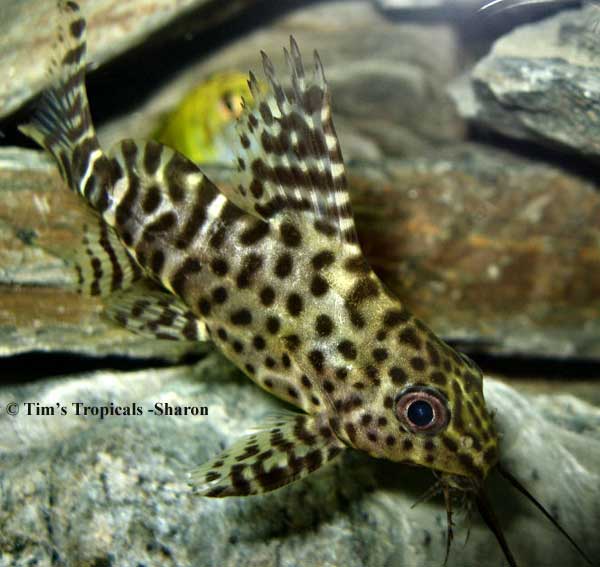
Upside Down Catfish
Upside Down Catfish - Compatibility:
The Upside Down Catfish is compatible with other synodontis catfish, Gouramis, Bettas, Silver
Hatchetfish, some Tetras, some Cichlids, Loaches, Plecos.
For a detailed list, use our compatibilty search.
Upside Down Catfish - Profile
-
Scientific Name: Synodontis nigriventris
-
Family: Catfish
-
Temperature: 22 - 26 C; 72 - 79 F
-
pH: 6.0 - 8.0
-
Size: 10 cm; 4 inches
-
Life Span: decades
-
Breeding: Difficult, Egglayer
Asian Glass Catfish
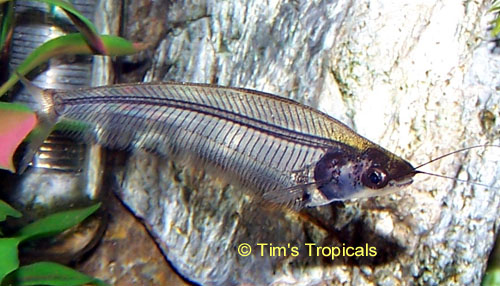
Asian Glass Catfish
The Asian Glass Catfish originates from southeast Asia.
They are also known as the Ghost Fish and the Ghost Glass Catfish.
They are an excellent community fish, but they are difficult to care for.
Their eye sight is poor. They have long barbells which help them to find food.
The body is transparent, allowing the skeleton to show through. The internal organs are all
near the head and are not transparent. Due to their lack of scales, they are very
sensitive to water temperature and quality
Asian Glass Catfish - Aquarium Setup
The Glass Catfish is unusual in that it swims in the mid levels of the tank instead of at the bottom.
The tank should have dim lighting, plenty of swimming room, some hiding places and
areas of water flow to simulate stream life.
They are fairly shy and should be isolated from areas of frequent human traffic.
Glass Catfish need the company of their own kind to survive and it is recommended to have
at least 5 or preferably 10 in a group.
The Glass Catfish cannot be combined with any aggressive types of fish.
Live food is an essential part of their diet and bloodworms are a favorite.
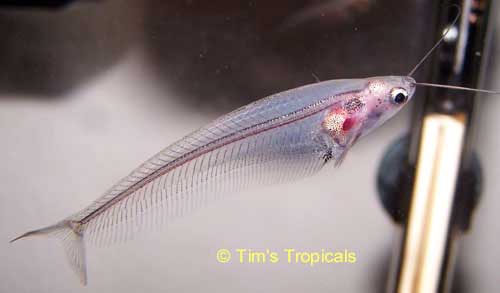
Asian Glass Catfish
Asian Glass Catfish - Breeding
Males are not distinguishable from females. Glass Catfish are imported from southeast Asia, because they cannot be successfully bred in captivity.
They are very difficult to ship successfully.
Asian Glass Catfish - Compatibility:
Asian Glass Catfish are compatible with Cories, Gouramis, Livebearers, Loaches, Tetras
(except the Serpae Tetra and Silver Tip Tetra are
too aggressive)
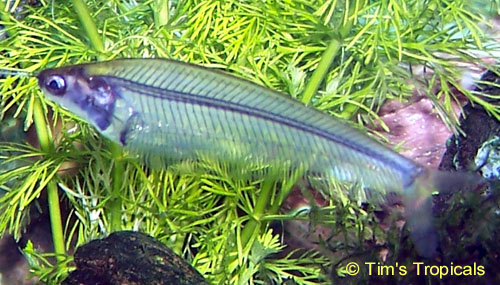
Asian Glass Catfish
Asian Glass Catfish - Profile
-
Scientific Name: Kryptopterus bicirrhis
-
Family: Catfish
-
Temperature: 21 - 26 C; 70 - 79 F
-
pH: 6.0 - 7.5
-
Size: 10 cm; 4 inches
-
Life Span: 6 - 8 years
-
Breeding: Difficult, Egglayer
African Glass Catfish
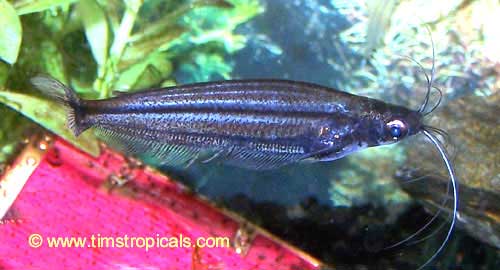
Pareutropius debauwi
Cuckoo Catfish
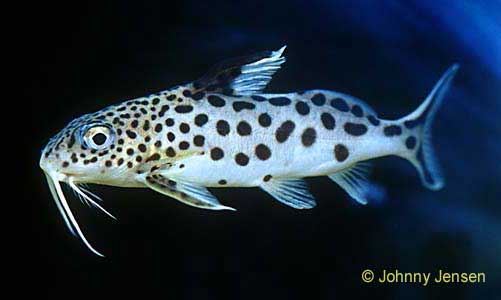
Cuckoo Catfish
Ocellated Catfish
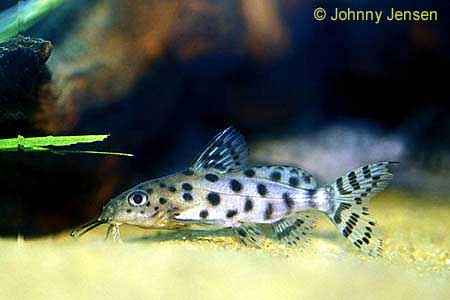
Synodontis Ocellifer
Otto Dwarf Sucker
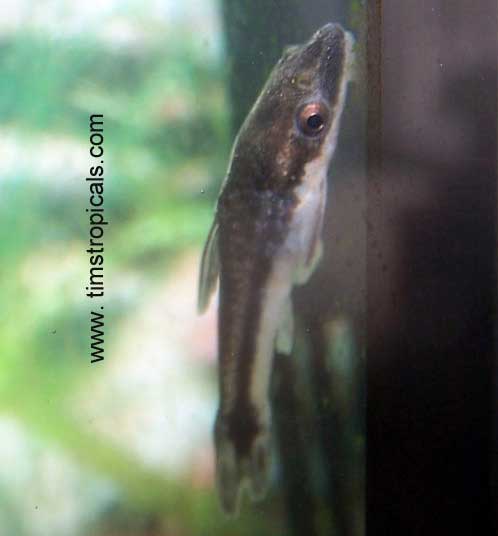
Otto
The Otto Dwarf Sucker originates from southeastern Brazil.
It is also known as the Oto, Otto, Golden Otocinclus, the Dwarf Suckermouth,
the Pygmy Suckermouth and the Midget Suckermouth Catfish.
The scientific species names for the Otto include Otocinclus affinis and Otocinclus vittatus.
The body shape and coloring are similar to a
Flying Fox and a Chinese Algae Eater.
There is a dark, black mottled band running from its head into its tail fin.
Below the banding it is silvery white.
Above the banding it is brown in a mottled pattern.
Water conditions should be very clean.
Otto Dwarf Sucker - Algae Eater
The Otto is the perfect algae eater. It eats soft algae exclusively, so make
sure a food supply is established in the tank before an Otto is introduced.
It will clean algae off of plants without harming the plant. It also will clean algae off of
plastic plants and glass.
Ottos are seldom active in a tank, but they are always entertaining to find.
They will stick themselves to the glass in any direction. They will stick to plant stems and
the underside of leaves.
Occasionally they will swim across the tank to take up a new resting or eating position.
Ottos won't harm other species and the only concern is that some larger,
aggressive fish, such as cichlids, will eat them.
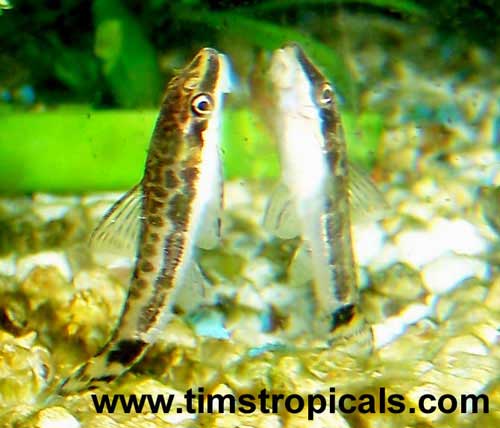
Otto
Although the literature indicates they should be kept in groups of three or more, I had a lone Otto for years and "Norbert" was
always a source of pleasure and a challenge to find. "He" went
through lots of tank mates without paying any attention to them and was impervious to disease.
Best of all, he loved algae all his life!
Otto Dwarf Sucker - Comments
Comments by LittleHippyGirl:
Ottos are cute little critters  If you have room, get more than one because they feel MUCH more secure in
groups. They only eat soft green and brown algae, nothing else. Most ottos in
pet stores are underfed, so a tank full of yummy algae would be heaven for a new
oto. They can be shy, so the best set up would be to have live plants. If you
don't want live, make sure there are plenty of broad-leaved silk plants for
them. In my experience, ottos aren't too fond of bare bottomed tanks (my quarantine
tank is bare bottom) so make sure you have gravel. They stay under 1.5" so
make sure no tank mate is big enough or will be big enough to eat them. They
have spiny fins so if the otto is swallowed, you will most likely end up with 2
dead fish.
If you have room, get more than one because they feel MUCH more secure in
groups. They only eat soft green and brown algae, nothing else. Most ottos in
pet stores are underfed, so a tank full of yummy algae would be heaven for a new
oto. They can be shy, so the best set up would be to have live plants. If you
don't want live, make sure there are plenty of broad-leaved silk plants for
them. In my experience, ottos aren't too fond of bare bottomed tanks (my quarantine
tank is bare bottom) so make sure you have gravel. They stay under 1.5" so
make sure no tank mate is big enough or will be big enough to eat them. They
have spiny fins so if the otto is swallowed, you will most likely end up with 2
dead fish.
Otto Dwarf Sucker - Aquarium Setup
Ottos are adaptable to a wide range of pH and water hardness, but adapting is
the hard part. They are usually more weak and stressed than most fish, and some
usually die within the first couple weeks of home-bringing. It is extremely
important to make the trip home as quick as possible, and acclimate them very
slowly to the new pH of your tank. Make sure their water is free of poisonous
ammonia and nitrite. I am happy to say that I had a 0% mortality rate with ottos!
This is odd and frankly I was expecting the two I bought a few months ago not to
make it because many of the fish I bring home are sick or overly stressed at the
pet store, and they only other 0% is bettas. Anyways, if they are strong enough
to adapt to your water and live past 2 weeks in their new tank, you will likely
never have any problems with them.
Some say that otos should only be kept in a planted tank (due to the plants aiding in better water quality and they also provide a bit of extra food if the algae is scarce, but I have had my guys for a long long time now and they are doing very well in my tanks that are all unplanted. It may come down to just the luck of the draw sometimes with these fish.
Advice on Buying Otocinclus
Thanks to Bernie for this Advice on Buying Otocinclus:
-
Never add them to a tank that hasn't been established for at least 6
mths.
-
Wait until they have been in the LFS for a few weeks before buying them and make sure there stomach is nice and round.
-
Avoid any fluctuations in any water parameters. As well as the normal ammonia/nitrite, they seem particularly sensitive to PH and nitrate fluctuations for some reason. Always try to keep nitrate below 10.
-
Keep dissolved oxygen levels up and have a relatively strong water current.
-
Try and have brown algae (diatoms) present in the tank, particularly when the otos are introduced, it is a great food source for them and it is their
favourite.
Otto Dwarf Sucker Compatibility:
Ottos are compatible with Corydoras, Danios, Gouramis, Guppies, Tetras, Loaches, Mollies, Platies, Sharks, Swords
Otto Suckermouth - Profile
-
Scientific Name: Otocinclus affinis
-
Family: Catfish
-
Temperature: 20 - 26 C; 68 - 79 F
-
pH: 6.0 - 8.0
-
Size: 4 cm;1.5 inches
-
Life Span: 7 years
-
Breeding: Difficult, Egglayer
|




